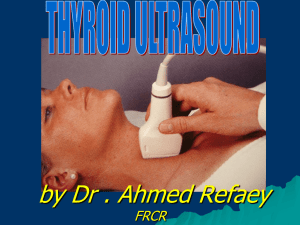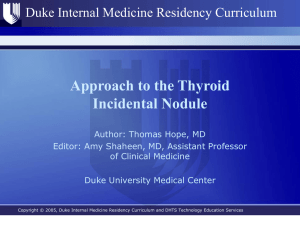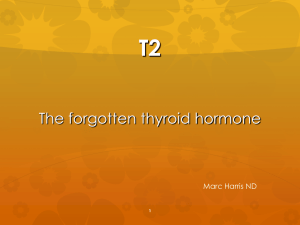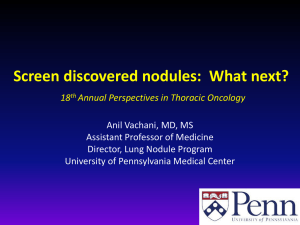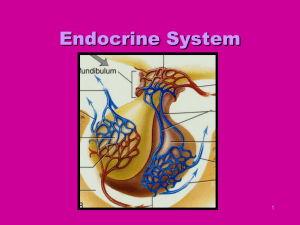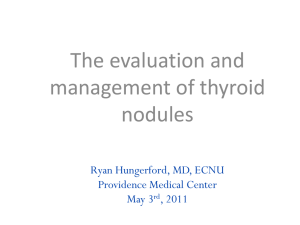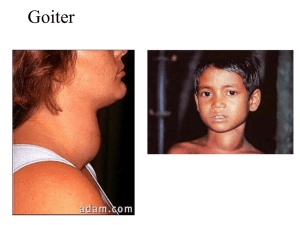THYROID NODULES
advertisement
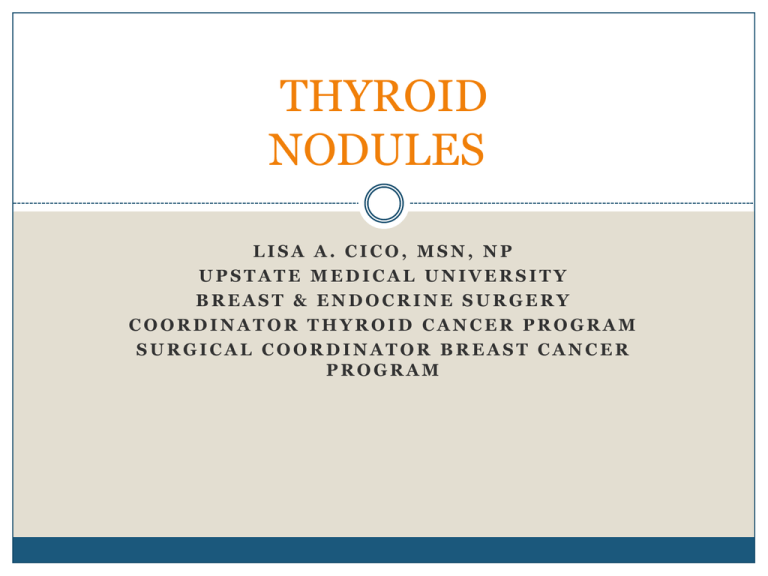
THYROID NODULES LISA A. CICO, MSN, NP UPSTATE MEDICAL UNIVERSITY BREAST & ENDOCRINE SURGERY COORDINATOR THYROID CANCER PROGRAM SURGICAL COORDINATOR BREAST CANCER PROGRAM Comprehensive review of current OBJECTIVES Describe tools / diagnostic testing for assessment of the patient with a thyroid nodule(s) *Utilize national guidelines developed for patients with thyroid nodules *Describe some of the common symptoms of patients with thyroid nodules diagnostic tools and imaging to assess thyroid nodules Review American Thyroid Association, & National Comprehensive Cancer Network Guidelines for patients who develop thyroid nodules Review common symptoms of patients with thyroid nodule Obtaining appropriate OBJECTIVES Identify which patients can safely be followed by PCP *Describe imaging/diagnostic modalities for following the patient with thyroid nodules *Identify those patients requiring referral to specialty *Identify which specialty to make an appropriate referral based on diagnostic, objective and symptomatic findings imaging/diagnostic testing, and frequency Overview of ultrasonographic thyroid terminology Overview of Betheseda thyroid nodule pathology terminology Obtaining appropriate personal and family history Identify what patients require referral and to endocrine or surgery? Briefly discuss appropriate follow up for the patient with thyroid cancer Definition of Thyroid Nodule “A discrete lesion within the thyroid gland that is palpably and/or ultrasonographically distinct from surrounding thyroid parenchyma” *ATA Management Guidelines for Patients with Thyroid Nodules and Differentiated Thyroid Cancer (2006 & 2009 Task Force) Prevalence Rallison et al. JAMA 1975 Hogan et al. J Surg Res 2009 60 50 40 Palpation Autopsy Ultrasound 30 20 10 0 10 20 30 40 50 60 70 “How was this nodule found?” Palpation with a physical exam Incidental finding on diagnostic work up Self detection Surveillance Work up for symptoms of hyper/hypothyroidism How was found is it clinically relevant? Physical Examination of Thyroid Gland Visual inspection Palpation of thyroid, neck nodes, and supraclavicular nodes Fixed, mobile, soft, tender? Reflexes why? HR, BP, weight Symptoms Usually NONE!! Occasionally painful, quick onset (cyst) Difficulty swallowing Hoarseness OR change in voice Shortness of breath (or difficulty swallowing) usually while supine OR hands raised over head (Pemberton’s Sign) Choking sensation hyper/hypo thyroid Symptoms? Nodules Hyper/Hypo thyroid Difficulty swallowing Hyper-functioning nodule Globus sensation Hashimoto’s Choking sensation Pertinent History & PE in Evaluation of TNs History Physical Findings Head & neck Rapid growth irradiation Whole body irradiation Nuclear fallout Family history of thyroid malignancy Heredity Hoarseness Cervical /supraclavicular lymphadenopathy Fixation of nodule or gland > 4 cm Solitary Differential Diagnosis Multinodular Goiter Hashimoto’s Thyroiditis Cancer Lymphoma Solitary Thyroid Nodule Substernal Goiter Family History of Hereditary Diseases COWDEN’S SYNDROME FAMILIAL POLYPOSIS CARNEY COMPLEX MEN 2 WERNER SYNDROME THYROID MALIGNANCY Substernal Goiters Short neck Stocky build Usually incidental finding by CXR or CT Many times treated unsuccessfully for asthma Ultrasound: The Gold Standard Anyone found to have, OR is suspected of having a nodule evaluate by ultrasound!! Pure cystic (relatively rare) Spongiform appearance in >50% of nodule volume (aggregration of multiple microcystic components) Multiple (?) BENIGN CHARACTERISTICS BENIGN Septated cyst BENIGN Cyst BENIGN US (a, transverse; b, longitudinal) scans in 51-year-old woman show 2.4-cm welldefined mixed-echoic hypoechoic nodule (arrows) in right lobe of thyroid gland. Initial cytologic result was adenomatous hyperplasia, confirmed after 11 months at repeat aspiration High-risk history: History of thyroid cancer in one or more first degree relatives; history of external beam radiation as a child; exposure to ionizing radiation in childhood or adolescence; prior hemithyroidectomy with discovery of thyroid cancer, 18FDG avidity on PET scanning; MEN2/FMTC-associated RET protooncogene mutation, calcitonin >100 pg/mL. MEN, multiple endocrine neoplasia; FMTC, familial medullary thyroid cancer. Suspicious features: microcalcifications; hypoechoic; increased nodular vascularity; infiltrative margins; taller than wide on transverse view. FNA cytology may be obtained from the abnormal lymph node in lieu of the thyroid nodule. Sonographic monitoring without biopsy may be an acceptable alternative ULTRASOUND CHARACTERISTIC CONSIDERATIONS Hypo-echogenicity compared to SUSPICIOUS CHARACTERISTICS normal thyroid parenchyma Increased intra-nodular vascularity Irregular infiltrative margins Presence of micro-calcifications Absent halo Shape taller than width in transverse dimension Nodules > 4 cm Solitary Difficulty swallowing ATA Guidelines 2009 Suspicious Hypoechoic Suspicious Increased vascularity SUSPICIOUS Increased vascularity SUSPICIOUS Calcifications Poorly defined, irregular margins SUSPICIOUS Solid Multiple Thyroid Nodules FNA what nodule?? > 1 cm Suspicious features Dominant / largest one FNA of Palpable Nodule Palpation? Ultrasound? What nodule(s) do you What nodule(s) do you FNA? FNA? TN with suppressed TSH UPTAKE SCAN to assess autonomous nodule Compare to U/S what is the correlation with Uptake FNA consider in non - functioning or isofunctioning with suspicious features FNA Only GOLD standard for proof of malignancy without surgical pathology FNA False Negative False Positive false-negative rate of ?? up to 5% with FNA which may be even higher with nodules >4 cm Is Size a Predictor of Malignancy? < 1 cm > 1 cm NO NO ATA Guidelines 2009 FNA Results Nondiagnostic Benign Atypia of Undetermined Significance (AUS) Suspicious for a Follicular Neoplasm/Follicular Neoplasm Suspicious for Malignancy Malignant Bethesda System for Reporting Thyroid Cytopathology Diagnostic Category Risk of Malignancy (%) Nondiagnostic or Unsatisfactory Usual management Repeat FNA with ultrasound guidance Benign 0-3 Clinical Follow up with ultrasound 6 months Atypia of Undetermined significance or Follicular lesion of Undetermined significance 5-15 Repeat FNA 3 months; if same, then lobectomy Follicular Neoplasm or suspicious for Follicular neoplasm 15-30 Surgical Lobectomy Suspicious for Malignancy 60-75 Near total thyroidectomy or surgical lobectomy Malignant 97-99 Near total thyroidectomy TSH Lab Work TSH Free T4 Free T4 TPO in suspected thyroiditis T4 T3 Free T3 TG tumor marker in PTC, FTC, HTC TPO Thyroglobulin (TG) Calcitonin Calcitonin suspected MTC or in follow up of MTC Thyroid nodule FNA Benign Exam/Sonogram 6-18 months No Change Repeat in 3-5 yrs 20% increase in diameter in > 2 dimensions (>2mm) or volume increase > 50% Re-aspirate Thyroid Nodule TABLE 3. SONOGRAPHIC AND CLINICAL FEATURES OF THYROID NODULES AND RECOMMENDATIONS FOR FNA Nodule sonographic or clinical features Recommended nodule threshold size for FNA High-risk historya Nodule WITH suspicious sonographic featuresb >5mm Recommendation A Nodule WITHOUT suspicious sonographic featuresb >5mm Recommendation I Abnormal cervical lymph nodes Allc Recommendation A Microcalcifications present in nodule ≥1cm Recommendation B AND hypoechoic >1cm Recommendation B AND iso- or hyperechoic ≥1–1.5 cm Recommendation C WITH any suspicious ultrasound featuresb ≥1.5–2.0 cm Recommendation B WITHOUT suspicious ultrasound features ≥2.0 cm Recommendation C Spongiform nodule ≥2.0 cmd Recommendation C Purely cystic nodule FNA not indicatede Recommendation E Solid nodule Mixed cystic–solid nodule RAI Uptake Scan ONLY IN HYPERTHYROID Cold Nodule - 10% incidence of being CA Thyroid Cancers From 2005 to 2009, incidence rates increased by 5.6% per year in men and 7.0% per year in women, making thyroid cancer the fastest increasing cancer in both men and women Most common endocrine cancer Projected Cases of Thyroid Cancer 60, 220 new cases are estimated for 2013 45, 310 female 14, 910 male 1,850 deaths projected for 2013 1,040 female 810 male Death rate 0.5 per 100,000 in both male and females AGE & INCIDENCE AMCERICAN CANCER SOCIETY / NCCN/ SEER Diagnosed at a younger age then most adult cancers Median age at diagnosis was 50 years from 2005-2009 2 out of 3 cases are < 55 years old Thyroid cancer in the pediatric population Pediatric Incidence 2.0 per 1 million in children <15 yrs and 17.6 per 1 million in children 15-19 yrs 2% occur in children and teens Surgery TREATMENT FOR Radioactive Iodine Ablation THYROID CANCER Levothyroxine Monitor with WBS / ultrasound CHILDREN & PREGNANT WOMEN WHEN DO YOU OPERATE??? Complications of Thyroid Surgery Recurrent laryngeal nerve injury Hypo parathyroidism Bleeding Infection COMPLICATIONS OF SURGERY Parathyroid glands COMPLICATIONS OF THYROID SURGERY OR case Surgery and TC Low MORTALITY Should be LOW MORBIDITY too!! Thyroid cancers LOW Mortality!! Rod Stewart, Julie Andrews, Joe Piscopo IF surgery is required, always refer to someone who does at least > 50 / year Always exceptions to the rules : Roger Ebert, Supreme Court Justice Reinquist NO drains!! NO RR tracks!! Dermabond is ulgy on the neck, and often opens a bit… Summary Refer to Endocrin0logy or Surgery Can safely follow with ultrasound Children Nodule < 1 cm Pregant women Stable nodules with no change Nodules > 1 cm with suspicious Repeat in 6 months x 2, then annually features Compressive symptoms HT with globus symptoms ULTRASOUND!! Even if already had CT, carotid doppler, etc Monitor TFTs with U/S Endocrine OR Surgery? ENDOCRINE Suspected/known abnormal TFTs with TNs Pregnant If FNA needed Children SURGERY If suspect surgery is indictated Thank You QUESTIONS?


